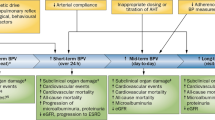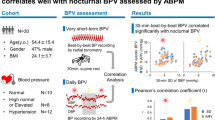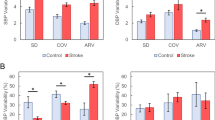Abstract
There is a real challenge in the management of ischemia with non-obstructive coronary artery disease. So, we need to study the mechanisms of persistent angina and non-obstructive coronary artery (ANOCA) patients. One of those possible mechanisms is blood pressure variability (BPV). We aimed to study the relation between BPV and angina in patients with non-obstructive coronary artery disease. Our study included 150 patients with chest pain and positive non-invasive stress test suggestive of myocardial ischemia and normal coronary angiography or non-obstructive coronary artery disease. We used an ambulatory blood pressure monitoring device. We found a positive correlation between BPV as measured by average real variability (ARV) as well as standard deviation (SD) parameters and the severity of anginal symptoms with P values for all parameters was 0.001 except day systolic SD P-value was 0.021. We performed a regression analysis for all statistically significant parameters. We found that 24H diastolic ARV, day diastolic ARV, night diastolic ARV, 24H diastolic SD, day diastolic SD, and night diastolic SD were independent predictors of the severity of angina with P-values (0.015, 0.007, 0.011, 0.037, 0.014, and 0.029), respectively. We concluded that short-term BPV represented by ARV and SD had a consistent association with angina in patients with non-obstructive coronary artery disease. The diastolic parameters of ARV and SD were independent predictors of the severity of angina with non-obstructive coronary artery disease.
This is a preview of subscription content, access via your institution
Access options
Subscribe to this journal
Receive 12 digital issues and online access to articles
$119.00 per year
only $9.92 per issue
Buy this article
- Purchase on Springer Link
- Instant access to full article PDF
Prices may be subject to local taxes which are calculated during checkout
Similar content being viewed by others

References
Marinescu MA, Loffler AI, Ouellette M, Smith L, Kramer CM, Bourque JM. Coronary microvascular dysfunction, microvascular angina, and treatment strategies. JACC Cardiovasc Imaging. 2015;8:210–20.
Bairey Merz CN, Pepine CJ, Walsh MN, Fleg JL. Ischemia and no obstructive coronary artery disease (INOCA): developing evidence‐based therapies and research agenda for the next decade. Circulation. 2017;135:1075–92.
Libby P, Pasterkamp G. Requiem for the ‘vulnerable plaque’. Eur Heart J. 2015;36:2984–7.
Agha M, Agha R. The rising prevalence of obesity: part A: impact on public health. Int J Surg Oncol. 2017;2:e17.
Danaei G, Finucane MM, Lu Y, Singh GM, Cowan MJ, Paciorek CJ. et al. National, regional, and global trends in fasting plasma glucose and diabetes prevalence since 1980: systematic analysis of health examination surveys and epidemiological studies with 370 country-years and 2.7 million participants. Lancet. 2011;378:31–40.
Tona F, Serra R, Di Ascenzo L, Osto E, Scarda A, Fabris R, et al. Systemic inflammation is related to coronary microvascular dysfunction in obese patients without obstructive coronary disease. Nutr Metab Cardiovasc Dis. 2014;24:447–53.
Li CL, Liu R, Wang JR, Yang J. Relationship between blood pressure variability and target organ damage in elderly patients. Eur Rev Med Pharm Sci. 2017;21:5451–5.
Pierdomenico SD, Di Nicola M, Esposito AL, Di Mascio R, Ballone E, Lapenna D, et al. Prognostic value of different indices of blood pressure variability in hypertensive patients. Am J Hypertens. 2009;22:842–7.
Sicari R, Nihoyannopoulos P, Evangelista A, Kasprzak J, Lancellotti P, Poldermans D, et al. Stress echocardiography expert consensus statement: European Association of Echocardiography (EAE) (a registered branch of the ESC). Eur J Echocardiogr. 2008;9:415–37.
Henzlova MJ, Duvall WL, Einstein AJ, Travin MI, Verberne HJ. ASNC imaging guidelines for SPECT nuclear cardiology procedures: stress, protocols, and tracers [published correction appears in J Nucl Cardiol. 2016 Jun;23(3):640–2]. J Nucl Cardiol. 2016;23:606–39.
Campeau Lucien. Grading of angina pectoris. Circulation. 1976;54:5223.
Williams B, Mancia G, Spiering W, Rosei EA, Azizi M, Burnier M, et al. ESC/ESH guidelines for the management of arterial hypertension. J Hypertens. 2018;2018:1953–2041.
Volpe M, Gallo G, Battistoni A, Tocci G. Highlights of ESC/ESH 2018 guidelines on the management of hypertension: what every doctor should know. High Blood Press Cardiovasc Prev. 2019;26:1–8.
O’Brien E, Parati G, Stergiou G, Asmar R, Beilin L, Bilo G, et al. European society of hypertension position paper on ambulatory blood pressure monitoring. J Hypertens. 2013;31:1731–68.
Sander D, Kukla C, Klingelhöfer J, Winbeck K, Conrad B. Relationship between circadian blood pressure patterns and progression of early carotid atherosclerosis: a 3-year follow-up study. Circulation. 2000;102:1536–41.
Björklund K, Lind L, Zethelius B, Berglund L, Lithell H. Prognostic significance of 24-h ambulatory blood pressure characteristics for cardiovascular morbidity in a population of elderly men. J Hypertens. 2004;22:1691–7.
Pringle E, Phillips C, Thijs L, Davidson C, Staessen JA, de Leeuw PW, et al. Systolic blood pressure variability as a risk factor for stroke and cardiovascular mortality in the elderly hypertensive population. J Hypertens. 2003;21:2251–7.
Kikuya M, Hozawa A, Ohokubo T, Tsuji I, Michimata M, Matsubara M, et al. Prognostic significance of blood pressure and heart rate variabilities: the Ohasama study. Hypertension. 2000;36:901–6.
Verdecchia P, Angeli F, Gattobigio R, Rapicetta C, Reboldi G. Impact of blood pressure variability on cardiac and cerebrovascular complications in hypertension. Am J Hypertens. 2007;20:154–61.
Clark D III, Nicholls SJ, St John J, Elshazly MB, Ahmed HM, Khraishah H, et al. Visit-to-visit blood pressure variability, coronary atheroma progression, and clinical outcomes. JAMA Cardiol. 2019;4:437–43.
Sebo P, Pechere-Bertschi A, Herrmann FR, Haller DM, Bovier P. Blood pressure measurements are unreliable to diagnose Hypertension in primary care. J Hypertens. 2014;32:509–17.
Aoyama R, Takano H, Suzuki K, Kubota Y, Inui K, Tokita Y, et al. The impact of blood pressure variability on coronary plaque vulnerability in stable angina: an analysis using optical coherence tomography. Coron Artery Dis 2017;28:225–31.
Schlaich MP, Parnell MM, Ahlers BA, Finch S, Marshall T, Zhang WZ, et al. Arginine transport and endothelial function in hypertensive and genetically predisposed normotensive subjects. Circulation. 2004;110:3680–6.
Owlia M, Dodson JA, King JB, Derington CG, Herrick JS, Sedlis S. et al. Angina severity, mortality, and healthcare utilization among veterans with stable angina. J Am Heart Assoc. 2019;8:e012811.
Campeau L. The Canadian cardiovascular society grading of angina pectoris revisited 30 years later. Can J Cardiol. 2002;18:371–9.
Kaul P, Naylor CD, Armstrong PW, Mark DB, Theroux P, Dagenais GR. Assessment of activity status and survival according to the Canadian cardiovascular society angina classification. Can J Cardiol. 2009;25:e225–31.
Acknowledgements
We want to thank the nurses and residents for helping us in conducting this study.
Funding
The authors received no specific funding for this work.
Author information
Authors and Affiliations
Corresponding author
Ethics declarations
Conflict of interest
The authors declare that they have no conflict of interest.
Additional information
Publisher’s note Springer Nature remains neutral with regard to jurisdictional claims in published maps and institutional affiliations.
Rights and permissions
About this article
Cite this article
Alaarag, A., Amin, O. Blood pressure variability in patients with angina and non-obstructive coronary artery disease. J Hum Hypertens 35, 1074–1080 (2021). https://doi.org/10.1038/s41371-020-00475-3
Received:
Revised:
Accepted:
Published:
Issue Date:
DOI: https://doi.org/10.1038/s41371-020-00475-3


